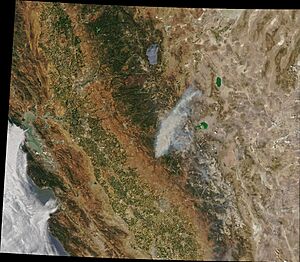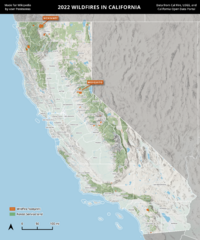2022 California wildfires facts for kids
Quick facts for kids 2022 California wildfires |
|
|---|---|

The smoke plume from the Oak Fire in California as seen by NASA's Aqua satellite on July 23, 2022
|
|
| Statistics | |
| Total fires | 7,667 |
| Total area | 363,939 acres (147,281 ha) |
| Date(s) | January 21–October 23 |
| Buildings destroyed |
|
| Deaths | 9 |
| Map | |
 A map of every wildfire ≥1,000 acres in area in California in 2022 |
|
| Season | |
|
← 2021
2023 →
|
|
The 2022 California wildfire season was a time when many wildfires happened across the state of California. By the end of 2022, there were 7,667 fires. These fires burned about 363,939 acres of land. To give you an idea, one acre is about the size of a football field.
Sadly, these fires caused nine deaths. They also destroyed 772 buildings and damaged 104 others. The 2022 season was much less severe than the 2020 and 2021 seasons. Those years had the most land burned in California's history.
Scientists expected another tough fire season in 2022. This was because of climate change and a long-term drought. However, the total area burned in 2022 was much lower than the average for the past five years. This was good news for California.
The worst time for fires in California is usually late summer or fall. It ends when a lot of rain falls across the state. California's Governor, Gavin Newsom, announced that the main fire season was over in mid-November. State officials were happy about the quieter year. News reports said that good weather, like rain at the right time and helpful winds, played a big part. Officials also mentioned that money spent on preventing fires, like controlled burning, might have helped.
Even though less land burned, some big fires still happened in 2022. These included the Oak Fire in Mariposa County, which destroyed over 180 buildings. The McKinney Fire in Siskiyou County caused four deaths. The Mosquito Fire in Placer and El Dorado counties was the largest fire of the year.
Contents
What Caused the Fires?
Climate Change and Fires
Climate change is one reason why wildfires in California are getting worse. For example, warmer temperatures make it easier for fires to spread even at night. Usually, nights are cooler, which helps firefighters control the blazes.
The Impact of Drought
California has been very dry for a long time. The state had its driest January to March period ever in 2022. This dryness is part of a 22-year drought in the western United States. It's the driest period in at least 1,200 years.
Drought makes wildfires more likely and more severe in several ways:
- Dry Plants: Plants and trees become very dry, making them easy to burn.
- Insect Problems: Drought also weakens forests, making them more open to bark beetle attacks. These beetles kill trees, which then become more fuel for fires.
- Dead Trees: Since 2010, over 172 million trees have died in California. This provides a huge amount of fuel for wildfires.
Forest Management and Firefighting
Before Europeans came to California, much more land used to burn each year. This happened naturally from wildfires and from Native Americans doing controlled burning. For a long time, the main way to manage wildfires was to put them out as fast as possible. This approach, called "fire suppression," has led to a lot of extra fuel building up in forests. Now, when fires do start, they can become much larger and more extreme.
Homes in Wildfire Areas
More and more homes are being built in areas where wildlands meet developed areas. This is called the wildland-urban interface (WUI). These areas are more likely to have fires start and more buildings get destroyed. This increases the risk and severity of fire seasons in California. For example, the 2018 Camp Fire and 2017 Tubbs Fire caused huge losses in WUI communities.
Preparing for Fire Season
Seasonal Fire Risk
After a wet end to 2021, California had its driest January and February ever in 2022. This dry spell continued into March. This followed a serious drought that started in 2020. This drought had made the 2020 and 2021 fire seasons very bad.
Experts predicted a higher risk of big fires in some areas starting in May. This was due to the lack of rain and the early start of the growing season. They expected the risk to spread across most areas in June and July.
In Northern California, the busiest fire season usually starts in early summer (June–July) and lasts until late fall. In Southern California, it starts in late spring (May–June) and lasts until fall. Fires can happen at any time of year, especially in drier Southern California.
Fire Prevention Efforts
To get ready for the 2022 fire season, the Pacific Gas and Electric Company (PG&E) spent more money on preventing wildfires. They planned to spend $5.96 billion in 2022.
Their plan included:
- Burying at least 175 miles of power lines in high-risk areas.
- Adding 98 more cameras and 100 more weather stations to detect fires.
- Improving safety systems that turn off power when things like trees touch power lines.
- Continuing to turn off power in extreme fire weather as a last resort.
These steps were taken after PG&E faced problems related to past wildfires. For example, the Dixie Fire in 2021, one of California's largest fires, was caused by a tree hitting PG&E power lines.
Firefighter Shortages
Before the 2022 fire season, there were worries about having enough firefighting staff. Officials said that fewer people were applying for firefighting jobs. This was partly because of low pay and the high cost of living in California.
Between 2019 and 2021, the number of U.S. Forest Service firefighters in California dropped by more than 1,000. In some areas, only half the needed firefighters had been hired. This was due to competition from other organizations like Cal Fire.
List of Major Wildfires
Here is a list of some important fires from 2022. These fires either burned more than 1,000 acres, caused a lot of damage, or were otherwise notable.
| Name | County | Acres | Start date | Containment date | Notes | Ref |
|---|---|---|---|---|---|---|
| Airport Fire | Inyo | 4,136 | February 16, 2022 | February 26, 2022 | Cause unknown | |
| Coastal Fire | Orange | 200 | May 11, 2022 | May 17, 2022 | Cause unknown; burned into a neighborhood and destroyed 20 homes | |
| Lost Lake Fire | Riverside | 5,856 | May 26, 2022 | June 8, 2022 | Cause unknown | |
| Thunder Fire | Kern | 2,500 | June 22, 2022 | June 27, 2022 | Likely caused by lightning strike | |
| Roblar Fire | Sonoma | 63 | June 27, 2022 | June 27, 2022 | Cause unknown; 1 person died after being trapped in a vehicle | |
| Electra Fire | Amador, Calaveras | 4,478 | July 4, 2022 | July 28, 2022 | Cause unknown, possibly fireworks from Fourth of July celebrations | |
| Washburn Fire | Mariposa, Madera | 4,886 | July 7, 2022 | July 30, 2022 | Caused by humans, led to evacuations in Wawona and closed trails in Yosemite National Park; threatened Mariposa Grove | |
| Oak Fire | Mariposa | 19,244 | July 22, 2022 | September 2, 2022 | Cause unknown, led to evacuations in Mariposa County. Destroyed 182 buildings and damaged 10 | |
| McKinney Fire | Siskiyou | 60,138 | July 29, 2022 | September 7, 2022 | Possibly caused by power lines; destroyed 185 buildings and caused 4 deaths | |
| Yeti Fire | Siskiyou | 7,886 | July 29, 2022 | September 1, 2022 | Likely caused by lightning, led to evacuations in Siskiyou County | |
| Summit Fire | Tulare | 1,394 | August 3, 2022 | October 31, 2022 | Caused by lightning, burned in southern Sequoia National Park | |
| Red Fire | Mariposa, Madera | 8,364 | August 4, 2022 | September 28, 2022 | Caused by lightning, burned in Yosemite National Park | |
| Six Rivers Lightning Complex | Humboldt, Trinity | 41,596 | August 5, 2022 | November 3, 2022 | Caused mandatory evacuations in Trinity and Humboldt counties, was a group of lightning fires that merged | |
| Rodgers Fire | Tuolumne | 2,790 | August 8, 2022 | September 26, 2022 | Caused by lightning, burned in Yosemite National Park | |
| Route Fire | Los Angeles | 5,208 | August 31, 2022 | September 7, 2022 | Burned near Interstate 5 and Castaic Lake, 1 building destroyed and 7 firefighters hurt | |
| Border 32 Fire | San Diego | 4,456 | August 31, 2022 | September 5, 2022 | Burned near the U.S./Mexico border, 10 buildings destroyed | |
| Mill Fire | Siskiyou | 3,935 | September 2, 2022 | September 13, 2022 | Burned in/near Weed and Lake Shastina, destroyed 118 buildings, caused 2 deaths | |
| Mountain Fire | Siskiyou | 13,440 | September 2, 2022 | September 21, 2022 | Burned 7 miles southwest of Gazelle, 4 buildings destroyed | |
| Radford Fire | San Bernardino | 1,079 | September 2, 2022 | September 30, 2022 | Burned near Big Bear Lake, caused evacuations | |
| Fairview Fire | Riverside | 28,307 | September 5, 2022 | October 5, 2022 | Burned near Hemet, caused 2 deaths and destroyed 36 buildings | |
| Mosquito Fire | Placer, El Dorado | 76,788 | September 6, 2022 | October 23, 2022 | Burned near Foresthill and caused evacuations in Placer and El Dorado County; destroyed 78 buildings | |
| Barnes Fire | Modoc | 5,843 | September 7, 2022 | October 13, 2022 | Caused by lightning, burned near Fort Bidwell in the Warner Mountains | |
| Fork Fire | Madera | 819 | September 7, 2022 | September 13, 2022 | Caused by a vehicle, destroyed 43 buildings near North Fork |
Learn More
- List of California wildfires
- 2022 Arizona wildfires
- 2022 Colorado wildfires
- 2022 New Mexico wildfires
- 2022 Oregon wildfires
- 2022 Washington wildfires

